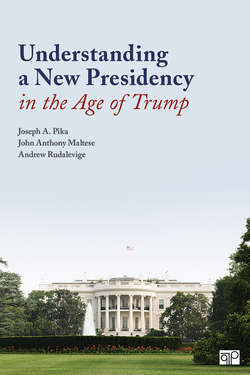Читать книгу Understanding a New Presidency in the Age of Trump - Joseph A. Pika - Страница 7
На сайте Литреса книга снята с продажи.
Understanding a New Presidency in the Age of Trump
ОглавлениеPhoto 1 London’s Evening Standard expresses the surprise shared by many around the world—including Trump himself—after his upset electoral victory on November 8, 2016.
DANIEL LEAL-OLIVAS/AFP/Getty Images
Donald J. Trump’s election on November 8, 2016, has been described as “one of the most stunning upsets in American political history.”1 Although Trump and his rival, Hillary Rodham Clinton, both went into Election Day with historically high “unfavorable” ratings,2 conventional wisdom held that Clinton would win. That is what projection models and most veteran observers predicted. Even the Republican National Committee’s own internal calculations showed Trump coming up short of the 270 electoral votes needed to secure victory.3 On the day of the election, Nate Silver’s widely reported election forecast gave Clinton a 71 percent chance of winning the White House, and exit polls showed Clinton winning four crucial swing states that ended up going to Trump.4 Based on the polls, Trump later confessed that he went to his wife on Election Day and said, “Baby, I tell you what. We’re not going to win tonight.”5
But win he did, breaking through the Democrats’ vaunted “blue wall” of the upper Midwest to carve out a majority in the Electoral College. And with the win came the monumental task of transitioning to power. On Election Night, the president-elect promised he would stress national unity after the hugely divisive campaign:
[T]o all Republicans and Democrats and independents across this nation I say it is time for us to come together as one united people. It’s time. I pledge to every citizen of our land that I will be president for all of Americans, and this is so important to me.6
Even under the best of circumstances, the presidential transition from one administration to another and from campaigning to governing is a formidable challenge. The Trump experience has been particularly bumpy. In order to help us understand this new presidency, the following discussion traces how Trump adjusted to his role as president—and how America adjusted to President Trump. We begin in Section I by recounting the transition, between Election Day and Trump’s swearing-in on January 20, 2017, and then, in Section II, by focusing on the events of Inauguration Day itself. Section III assesses Trump’s first hundred days in office, organizing the analysis around the president’s roles in the legislative process, executive management, and communicating with the public. Section IV then pushes the timeline past an unusually intense second hundred days, which some observers had predicted would be a better measure of Trump’s success than the first.7 Faced with growing distractions and legislative failure on the domestic front, Trump—who had campaigned as an isolationist—increasingly turned his attention abroad. Section V examines continuity and change in Trump’s evolving foreign policy, and asks, did an overarching Trump Doctrine emerge? Finally, a concluding section reflects more broadly on the challenges posed by the Trump presidency to James Madison’s system of shared but competing governmental powers.
